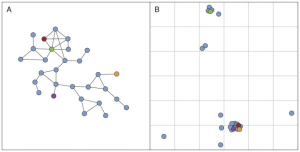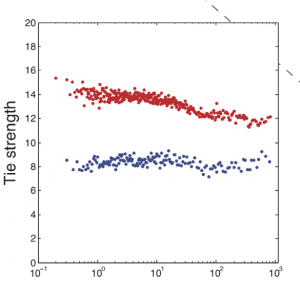Geography and Networking
This study uses analysis of cell phone data to determine social networks. Two people calling or texting creates a tie between them, and the study uses the distance between their cell phone billing addresses as the approximate distance between the two individuals. People then voluntarily reported who their actual friends were in a blog. “Communities” were created using the researchers community detection model, called “modularity maximization”. Once communities determined by the algorhythmwere created based off frequency of cellular communication, they were analyzed to produce the data.
I found that the most useful information in the study was displayed on the graphs. There was a network graph that displayed the cell phone network and the correlated points on a map of geographical location that was very insightful as to how people who were close on a cellular level might not be close to each other geographically (below).

However, nodes in the cellular network that formed communities often were close to each other geographically. The study showed the probability of a cellular tie depended on distance, but the tie strength did not depend on geographical distance. (below, distance is in kilometers). In the graph, the red dots represent calls and the blue texts. The tie strengths were self-reported from the blog.
When they analyzed communities, they found that small communities under 30 individuals tended to be geographically constrained to under 50 km, but larger ones were not. Larger communities (in terms of number of people) tended to have smaller geographical clusters within them. This alligns with the concept of local bridges that says that certain crucial individuals play a large role in connecting two otherwise disconnected social communities. Edges that were bridges were very important for larger communities, and they were how the larger communities spread much larger geographical distances than the small ones. This is intuitive that there would be many bridges in a cellular network because most people contact other people that are close to them geographically.
http://journals.plos.org/plosone/article?id=10.1371/journal.pone.0016939

